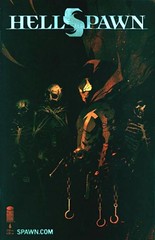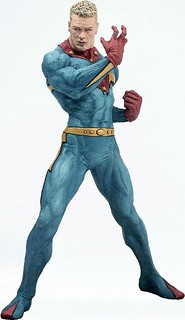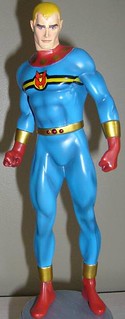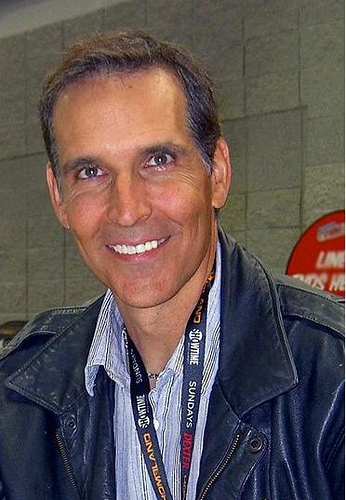[Previous chapters: 1 to 8 – 1953 – 1985 Roundup, 9 – The Dawn of Eclipse, 10 – Alan Moore at Eclipse, 11 – The Twilight of Eclipse, 12 – All About Angela]

UGO: Has the Miracleman film gone back to Neil Gaiman or wherever it is supposed to go?
TMcF: With the lawsuit, Gaiman walked away from Miracleman. I have the trademark for Miracleman. No one wants to say it out loud, but that’s what happened with the lawsuit. Everyone was like ‘Hah hah, he killed Todd,’ but unfortunately – or fortunately, depending on where you are standing – he had to pick some copyrights to some Spawn characters or pick Miracleman. He didn’t pick Miracleman.
UGO: Did he take Angela?
TMcF: Yeah, he took some of the Spawn stuff. For whatever reason he walked away from Miracleman, so now Miracleman will be in the Image 10th Anniversary Book.
…although Neil Gaiman took a different view:
Good old Todd. This was the same kind of thing he was doing in the fan press before the legal case. Charitably, I think it’s fair to say that he’s telling huge and easily disprovable fibs. No, he doesn’t (whatever he says in the interview) have a trademark on Miracleman. The shared trademark that Eclipse had was found to have expired in the mid 90s, before Todd bought the remains of Eclipse. (Todd put in a new Miracleman trademark application back in 2001, before the legal case, which we opposed as soon as we found out about it, and which hasn’t been granted.)
Beyond that, he’s also distancing himself from the reality-based community in his description of the result of the legal case. (I’m not sure what to say about that, other than it’s all been pretty extensively recorded.) If Todd actually owned a share of Miracleman (something that became more and more unlikely as we finally saw the actual documentation he had on it, which consisted only of: a contract that said that Eclipse’s rights to the character automatically reverted if someone other than Dean Mullaney owned Eclipse, and an expired Trademark notice for a Trademark shared with me, Mark Buckingham and Eclipse) then, yes, he kept that share at the end of the trial. Meanwhile, Mark Buckingham and my share of Miracleman isn’t in any doubt at all. I didn’t walk away from what Todd had; Todd simply couldn’t demonstrate that he owned anything that I was walking away from.

In April 2003 he released a large Miracleman statue through his McFarlane Toys company, which he then had reissued as a four-inch figure for inclusion in a double pack with a Spawn figure in time for the San Diego Comic-Con in July that year. Neil Gaiman thought that it looked ‘clenched,’ and licensed one of his own that appeared in 2005. Speaking to Comic Book Resources in June 2003 he said,
I thought it was astonishingly ugly! What we’ve actually done is, Marvels and Miracles has licensed Miracleman to Randy Bowen on the basis that I really like Randy’s stuff and he did all the nicest Sandman statues, so he’s going to be doing a Miracleman statue. Mainly just to go, ‘No no no, Miracleman doesn’t look like that. He doesn’t clench!’ The Todd one is terribly clenched.


[There’s the two of them, so you can judge for yourself. I leave it as an exercise for the reader to figure out which is which.]

Considering that Todd McFarlane was claiming that he owned Miracleman free and clear, he seemed to have been very shy of actually just going ahead and publishing a comic with a clearly identified Miracleman character in it. In fact, he seemed to be acting in exactly the opposite manner to how you’d expect someone who was sure they owned something would: If he really owned Miracleman, as he continually claimed, surely he would have met Gaiman’s legal challenge to his publishing Hellspawn #13 – which was to feature the return of Miracleman – head on, instead of giving in to it. He was, after all, no stranger to the inside of a courtroom at this stage. And he would have started calling the unnamed character he used in the Image 10th Anniversary Book Miracleman, if he owned the rights to the character, instead of having to evolve a completely different name and origin for it after being warned away by Gaiman.
As to why McFarlane kept pursuing a course that was pretty obviously colossally stupid, who knows? Perhaps he thought that, in the same way that Dez Skinn had said he wished to do when he first published Marvelman in Warrior in 1982, he could establish rights in the character by the act of publishing it. Or perhaps he was hoping to provoke Gaiman into taking a case against him directly about the ownership of the character. There has also been speculation that one of the reasons that McFarlane bought the Eclipse Comics assets at the bankruptcy sale in February 1996 was so that, in getting Eclipse’s rights to Miracleman, he would have a bargaining chip to use against Gaiman in the fight over the rights for the characters they co-created in Spawn #9, along with their subsequent derivatives. (There’s also the whole issue of Spawn Pogs, which I simply refuse to go into.) One way or another, and for whatever reason, McFarlane used versions of the character quite a few times over the years, as noted above, to absolutely no advantage to himself, and to considerable disadvantage.
[*The Image 10th Anniversary Book is now more commonly known as the Image Hardcover, possibly due to it being published in 2005, three years after the anniversary it was meant to mark.]

This left me one of the biggest creditors of McFarlane’s bankrupt comics company. Because they’ve been in bankruptcy, he’s paid me nothing since the 2002 court case.
Now, some years later, McFarlane’s comics company is coming out of bankruptcy, and an accountant whom Todd and I have mutually agreed on is trying to sort out exactly how much money I’m owed.
Ken Levin told me,
The court cases are not yet fully resolved with several still open questions. An arbitrator, who was mutually selected by Todd McFarlane and Neil Gaiman under an agreement made before the case originally went to trial in Wisconsin federal court, was in the process of determining how much was owed to Neil when his efforts were stopped due to comic book company Todd McFarlane Productions entering Chapter 11 bankruptcy because of an unrelated lawsuit involving Mr. McFarlane and Tony Twist, which as of now no longer prevents the arbitrator from finishing his work. Which he is in the process of doing. However, even when the arbitrator finishes with his findings they will then need to be reviewed by the trial court, and then could be subject to further appeal.
In the meantime, McFarlane was, once again, back in court, this time for infringing the copyright of the characters from Spawn #9. In the same post as above, Gaiman says,
There are some knock-offs of the characters I’ve co-created that Todd published and made toys of over the years, and I felt they were derivative of the characters I’d created (or in one case, one actually was the same character I’d created). Todd didn’t want to pay anything at all on them so he (not me/my lawyers) took it back before the judge. […] We’re now waiting for a ruling on if those characters are (in my opinion) derivative or (Todd’s opinion) not of the characters I co-created and have an established copyright interest in.

Both Medieval (Gaiman) Spawn and Dark Ages (McFarlane) Spawn committed bad deeds in the past for which they want to make amends, both have sisters whom they loved who married men who were or became the Hellspawn’s enemies; both made a deal with the devil to let them return to Earth; and both use their powers to help the defenseless. The two characters are visually similar: both wear metal helmets and face masks with rivets; both ride horses and carry oversized swords and battle shields; both have armor shoulder pads with spikes. Both have aspects of the first Al Simmons Spawn: a ‘neural parasite cloak,’ a particularly shaped face mask, green eyes and a red ‘M’ on the chest.
Tiffany and Domina are visually similar to Angela and share her same basic traits. All three are warrior angels with voluptuous physiques, long hair and mask-like eye makeup. All three wear battle uniforms consisting of thong bikinis, garters, wide weapon belts, elbowlength gloves and ill-fitting armor bras. Angela and Domina each wear a long cloth draped between their legs and a winged headdress. Tiffany and Angela are shown in the Spawn Bible as having sharp wings. All three of these female characters are warrior angels who fight in the war between Heaven and Hell. When plaintiff conceived of Angela, he saw her as part of an army of 300,000 ‘female, kick-ass warrior angels, who are hunters, merciless and not very nice.’ Tiffany and Domina are part of this same heavenly army. Like Angela, Tiffany is described in the Spawn Bible as having failed to kill only one of the persons she intended to kill: Al Simmons, the original Spawn. Domina is a less developed character, but has superpowers substantially similar to Angela’s. She is described as having led angels into battle against the ‘superpowered Hell demon Urizen.’ Like Angela, she is headstrong and not inclined to obey Heaven’s commands.
I conclude that the newer characters are derivative and that plaintiff is entitled to his share of the profits realized by these characters and to the immediate production of all documents and other information material to the calculation of the profits.
As a result of this, McFarlane’s payout to Gaiman, when it finally happened, would now have to include payment for Gaiman’s portion of the profits deemed to have been earned by these characters, as well as what was previously due.
Even the judge in the 2010 case seemed puzzled that McFarlane couldn’t come up with a different character concept of his own, rather than try to publish a character who was pretty obviously a badly-disguised version of Medieval Spawn. At one point she said,
Much as defendant tries to distinguish the two knight Hellspawns, he never explains why, of all the universe of possible Hellspawn incarnations, he introduced two knights from the same century. Not only does this break the Hellspawn ‘rule’ that Malebolgia never returns a Hellspawn to Earth more than once every four hundred years (or possibly every hundred years, as suggested in Spawn #9), it suggests that what defendant really wanted to do was exploit the possibilities of the knight introduced in issue #9. (This possibility is supported by the odd timing of defendant’s letter to plaintiff on February 14, 1999, just before publication of the first issue of Spawn: The Dark Ages, to the effect that defendant was rescinding their previous agreements and retaining all rights to Medieval Spawn.)
If defendant really wanted to differentiate the new Hellspawn, why not make him a Portuguese explorer in the sixteenth century; an officer of the Royal Navy in the eighteenth century; an idealistic recruit of Simon Bolivar in the nineteenth century; a companion of Odysseus on his voyages; a Roman gladiator; a younger brother of Emperor Nakamikado in the early eighteenth century; a Spanish conquistador; an aristocrat in the Qing dynasty; an American Indian warrior; or a member of the court of Queen Elizabeth I? It seems far more than coincidence that Dark Ages Spawn is a knight from the same century as Medieval Spawn.
…all of which inevitably led to a number of online pundits joking that the judge had a better imagination when it came to creating comic book characters than Todd McFarlane did.
Meanwhile, McFarlane had again tried to register the name Miracleman with the United States Patent and Trademark Office on the 11th of July 2010. This was opposed by Gaiman, pending some sort of final resolution of the rights to the name.
Then, after nothing much seemed to happen for a while, there was an announcement on the 30th of January 2012 that, three days previously, Gaiman and McFarlane had finally settled their legal dispute over Gaiman’s share of Spawn properties. According to a report on the Minnesota Public Radio website:
Fantasy industry giants Neil Gaiman and Todd McFarlane have agreed to settle their long-running legal battle over Gaiman’s share of the Spawn universe.
Their attorneys filed notice Friday in federal court in Madison saying they’ve reached a deal that calls for declaring Gaiman a 50% owner of Spawn issues #9 and #26, the first three issues of a spin-off series on the angels and the issues’ contents.
Jeffrey Simmons, one of Gaiman’s attorneys, declined to elaborate, saying the terms are confidential.
This was followed on the 24th of February by an order to release $382,000 McFarlane had paid into a third-party escrow account on 2008, along with any accrued interest, presumably as part-payment on McFarlane’s debt to Gaiman. This wasn’t the whole settlement, though, by a long way.
Writing about this at the time, I noted that Todd McFarlane needs to account for, and pay Neil Gaiman for, his share of quite a number of things, including:
- Spawn issues #9 and #26, presumably also including the proceeds of any reprints of these issues in trade paperbacks;
- The Angela miniseries and trade paperback;
- The Spawn movie, which featured some of the characters co-created in Spawn #9;
- The Spawn animated TV series, for the same reason as above;
- Video and DVD sales of both of the above;
- Any appearances of the characters Tiffany, Domina, and Dark Ages Spawn, that were found to be derivative of the characters in Spawn #9;
- And, finally, any action figures based on all the above characters.And, soon enough, we got to see some figures that looked a bit more like what we might have expected. On the 1st of May 2012 Legal Eagle Daniel Best, on his really excellent 20th Century Danny Boy blog, had this post, showing that, according to his Summary of Disbursements, as filed with the Bankruptcy Court in Arizona for the quarter-year ending on the 31st of March, 2012, and signed off by the judge on the 24th of April, Todd McFarlane has paid $1,100,000 to Neil Gaiman under the heading of Gaiman Settlement. It really did seem that the Gaiman-McFarlane dispute was finally over, and that the Marvelman/Miracleman property was free again.
At this point I should ask the question, is any of this relevant to the ongoing story of Marvelman and Miracleman? I think it is, very much so. Although it complicates the issues a hundredfold, the truth of the matter was that Todd McFarlane’s claim to own a portion – or indeed all of – the rights to Miracleman was unavoidably tied up with the ongoing court cases concerning Gaiman’s rights to the characters he created in Spawn #9, illustrated by the fact that the two separate sets of rights were at one point to be exchanged for one another.
There is also the fact that McFarlane had shown that he was very combative about these issues and, despite the fact that all the court cases he has been in involving Gaiman have gone against him in every detail, he shows no signs of actually behaving like an adult might be expected to, and conceding gracefully. Marvels and Miracles, the company set up by Neil Gaiman and Ken Levin to fund those cases, was specifically created to help in what Gaiman and Levin must have foreseen would be a long drawn-out process, both to uphold Gaiman’s rights to what he co-created, and to then finally clarify the rights position of Miracleman.
I asked Neil Gaiman and Kenneth Levin about the purpose of Marvels and Miracles. Levin replied,
There were a lot of questions about the Miracleman/Marvelman rights with many more questions than answers. It seemed prudent to create a single vehicle from which to deal with the rights we knew we had, and those we thought we had, and those we thought we would be getting, such as from some of the artists who were aligned with us and who also had certain rights. As Neil from the outset had publicly announced he would donate to charities whatever monies he might net from the row with Mr. McFarlane and his companies, Marvels & Miracles would also be the functional conduit to make those charitable donations, should that day ever come.
Gaiman said,
Ken Levin and I mapped out six primary goals when we began this adventure, over ten years ago:
One was to ultimately unify the Marvelman/Miracleman rights, and to allow the existing stories to become available to people, and at a price that those people could reasonably afford.
A second was to give Mark Buckingham and me the chance to finish telling the story we started.
A third was to stand up for creators’ rights – to show that creators do have an ownership interest in what they create unless they sign it away.
A fourth was to get some of the rules settled regarding the law of copyright as applicable to characters originally created for comic books, hopefully with the result that the creator would have some legal protections, which the federal Seventh Circuit’s opinion, upholding our trial court win and denying every issue raised in McFarlane’s appeal, did gloriously.
A fifth was to try and have the end result generate some benefits to some of the charities whose work I respect and support, such as the Comic Book Legal Defense Fund.
And the final one was to have some fun together while trying to achieve the goals we’d set. While it’s too early for a final completed scorecard, I am pleased at the results so far…
Meanwhile, across the Atlantic, things had been happening in Britain, and another player had entered the field.
To be continued…
[My apologies to anyone who has been following my reporting on the Neil Gaiman / Todd McFarlane story on my own blog, which is necessarily duplicated here, albeit in an updated form. More interesting stuff next week, I promise!]
The photograph of Todd McFarlane is by Luigi Novi, and the original can be found here. It is used here under the Creative Commons Attribution 3.0 Unported license.









“There’s also the whole issue of Spawn Pogs, which I simply refuse to go into.”
When the dead tree edition appears I’d hope this would merit a footnote.
I’ve read most of this on your blog before, as you noted at the end, but it’s always fascinating no matter when I read it.
I have an embarrassing confession…I bought the McFarlane statue at full price when it first came out. I was really excited for something new of Miracleman and…yeah, nostalgia trumped rational thought.
Kate, here’s a bit from a comment in last week’s episode regarding the Spawn Pogs (or as they were known, “Spogz”):
I think Steve Bissette mentioned on his blog how the main impetus for McFarlane going after the Eclipse assets in the first place was because McFarlane took out an ad for Spawn pogs in some Eclipse comics and he was worried that the bankruptcy auction could somehow mess up his Spawn copyrights. Which is pretty insane to think the whole Gaiman v McFarlane mess started because of pogs.
Eclipse actually published the pogs in question (excuse me, Spogz).
The other – entirely tangential – point that’s been troubling me is whether or not the ‘Tony Twist’ thing was intentional on McFarlane’s part or if he was just incredibly unlucky with his choice of gangster names…
Anyone else think that both Miracleman figures look uncomfortably clenched?
The McFarlane figure is bad in that predictably bad McFarlane aesthetic, but Gaiman’s Miracleman looks incredibly uncomfortably posed. McFarlane’s MM is trying to hard while Gaiman’s MM looks like he’s trying to hard to hold something in.
The Tony Twist name was totally intentional. IIRC McFarland mentions in a spawn letters column that the name is a shout out to one of his favorite players
Yes, Tony was a tough guy hockey player who got into a lot of fights. Those guys used to be called ‘enforcers’ because if somebody started messing with the star player, the enforcer would beat the shit out of them. Wayne Gretzky had somebody in that respect and it’s why he got as many points as he did.
Come to think of it, Tony probably *was* Wayne Gretzky’s enforcer when he played with him in 1996 on the St. Louis Blues.
Pogs have come in very handy for furniture bases on uneven flooring or carpeting.
@ Michael – “Late, here’s a bit from a comment in last week’s episode regarding the Spawn Pogs (or as they were known, “Spogz”):
“I think Steve Bissette mentioned on his blog how the main impetus for McFarlane going after the Eclipse assets in the first place was because McFarlane took out an ad for Spawn pogs in some Eclipse comics and he was worried that the bankruptcy auction could somehow mess up his Spawn copyrights. Which is pretty insane to think the whole Gaiman v McFarlane mess started because of pogs.”
@ Nat – “Eclipse actually published the pogs in question (excuse me, Spogz).”
Why would McFarlane farm out the pogs to Eclipse in the first place? Spawn seems to have been set up with multi-media exploitation in mind from the start and he held onto everything else, so why licence that one specific bit of merch to a company whose reputation was not exactly glowing in 1992/3?
“distancing himself from the reality-based community”…That cracked me up when I first read it years ago and has made me laugh again today. Thanks again Padraig.
for anyone wondering, i found the Bissette blog posts about McFarlane’s Spogz (from an old Beat post about Marvelman of course!)
http://srbissette.com/?p=13707
http://srbissette.com/?p=13736
Reader Matt O’Hara added them to the comments of this post
https://www.comicsbeat.com/must-read-gaimanmcfarlanemiracleman-the-saga/
Kate – your questions as to why Todd would license out Spogz goes unanswered. Makes no sense to me either! Maybe Todd was doing them a favor? Just speculation, I have no idea.
Kate: ‘“There’s also the whole issue of Spawn Pogs, which I simply refuse to go into.” When the dead tree edition appears I’d hope this would merit a footnote.‘
I really felt that having to do research into Pogs in general, and Spawn Pogs in particular, was the point at which I had to question what I was doing with my life. However, I suppose you have a point, and that I should really know enough about them to at least put in a footnote. Le sigh.
Comments are closed.